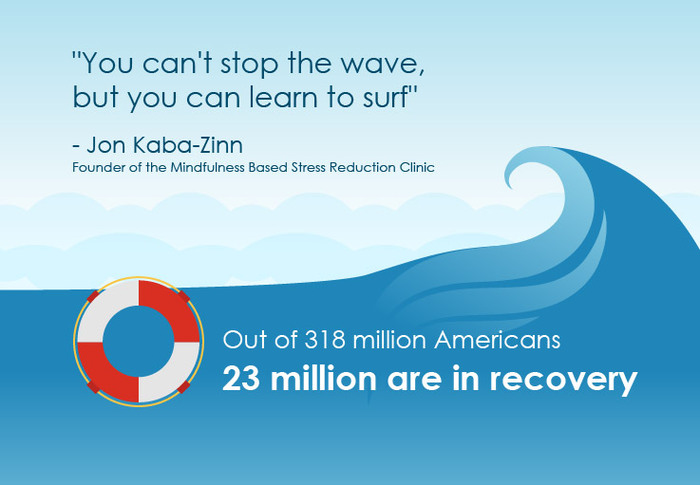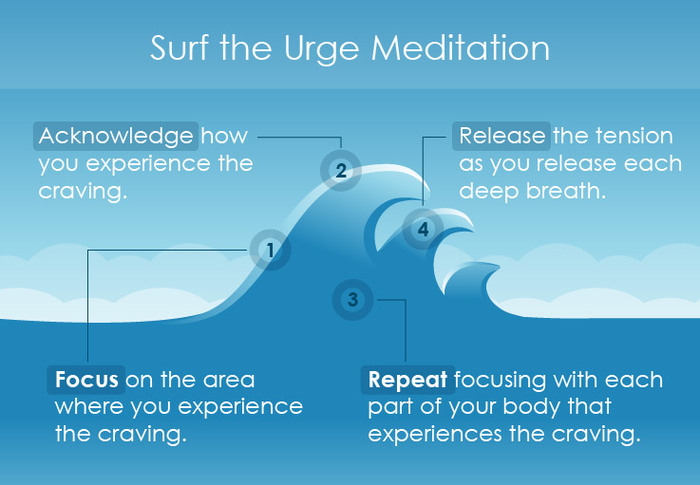“Surf the Urge” To Wipe Out Relapse
Powerful drug cravings can trigger a downward spiral that’s all too familiar with those in recovery: A fierce struggle to resist. Denial and justification. Relapse and regret.
Perhaps it’s time to stop fighting so hard.
A mini-meditation known as “urge surfing” has been shown to help people cope with cravings and high-risk situations. Instead of exerting steely resolve or buckling under stress, urge surfing teaches people to mentally detach from their experience. They take a pause, step back and visualize their craving as an ocean wave — riding with the urge as it starts to ripple, then rises and crests, and eventually falls.
“We’re teaching people to relate to their experiences differently,” says Dr. Sarah Bowen, a research scientist with the Center for the Study of Health and Risk Behaviors at the University of Washington. “Rather than trying to white-knuckle their way through a craving or avoid triggers, we’re teaching people to relate to their difficulty more skillfully.”
Dr. Bowen co-authored research on the technique with the late Dr. Alan Marlatt, who coined the term “urge surfing” and developed the widely-used Mindfulness Based Relapse Prevention (MBRP) protocol for addictive behaviors. Their research on urge surfing found that college smokers who practiced the technique had a 26 percent reduction in their smoking, more than twice that of a control group.
Trappings of the Mind
One of the greatest triggers for relapse, Bowen says, is what psychologists term “negative affect” — challenging emotions such as feelings of failure or bad moods that impair well-being. Urge surfing encourages people to be mindful and present with their discomfort, without being threatened or overwhelmed by it.
“Often, a craving is a cue for people to use drugs. This is an alternative way of coping with that experience, so that when a craving or urge does arrive, clients can learn how to recognize what’s happening,” Bowen says. “And by practicing being with that, they can learn that they have some choice.”
Results in Recovery
Rasha Salib sees the impact of urge surfing in her work as a therapist at Journey Malibu, a holistic drug and alcohol rehab center in California. She describes one recent group session, as recovering addicts were guided through self-mastery skills and an urge surfing meditation. They brainstormed ways to use urge surfing for other behaviors, such as the urge to eat when bored or the impulse to check a cell phone and instantly text back.
The urge surfing participants reported a new level of confidence in breaking bad habits. “Clients informed me that they cut down smoking by half, one client quit chewing tobacco, one client stopped purging for 2 days, and one client reported being more present and not concerned with the future as much,” Salib says.
Trying to fight drug cravings “is like trying to block a waterfall,” Salib says. She encourages her clients to watch the urges go by rather than start a fight, flight or freeze pattern. “Clients really find it helpful to know that it is the internal struggle that feeds the cravings and amplifies it,” she says. “All they have to do is allow (cravings) to pass and non-judgmentally notice them from a detached and curious perspective.”
The practice of mindfulness, Salib says, also helps people undo patterns of defensiveness and aggression. “They start to realize that no matter how others behave, they can nurture themselves and come to a place of inner balance and well being.”

How to Practice Urge Surfing
Urge surfing has potential to help the 23 million Americans in recovery from substance abuse. Learning the technique is easier with professional guidance; many holistic drug rehab centers incorporate urge surfing into their aftercare programs. There’s also a free audio recording developed by the Addictive Behaviors Research Center at the University of Washington.
To download the free meditation on urge surfing (approximately 8 minutes), go to: MindfulRelapsePrevention.com and scroll to the bottom of the page (shared with permission from Dr. Sarah Bowen).
People in recovery can also try this urge surfing exercise, reprinted with permission from the National Institute on Alcohol Abuse and Alcoholism (“Understanding the Impact of Alcohol on Human Health and Well-Being”).
Urges are a lot like ocean waves. They are small when they start, grow in size, and then break up and dissipate. You can imagine yourself as a surfer who will ride the wave, staying on top of it until it crests, breaks, and turns into less powerful, foamy surf . . . .
There are four basic steps in urge surfing:
- Acknowledge how you are experience the craving. Do this by sitting in a comfortable chair with your feet flat on the floor and your hands in a comfortable position. Take a few deep breaths and focus your attention inward. Allow your attention to wander through your body. Notice where in your body you experience the craving and what the sensations are like. Notice each area where you experience the urge, and tell yourself what you are experiencing. For example, “Let me see . . . My craving is in my mouth and nose and in my stomach.”
- Focus on one area where you are experiencing the urge. Notice the exact sensations in that area. For example, do you feel hot, cold, tingly, or numb? Are your muscles tense or relaxed? How large an area is involved? Notice the sensations and describe them to yourself. Notice the changes that occur in the sensation. “Well, my mouth feels dry and parched. There is tension in my lips and tongue. I keep swallowing. As I exhale, I can imagine the smell and tingle of alcohol.”
- Repeat the focusing with each part of your body that experiences the craving. Pay attention to and describe to yourself the changes that occur in the sensations. Notice how the urge comes and goes.
- Ride out your craving, releasing tension with each breath. Stay with the meditation until the craving subsides. Many people, when they urge surf, notice that after a few minutes the craving has vanished. The purpose of this exercise, however, is not to make the craving go away but to experience the craving in a new way. If you practice urge surfing, you will become familiar with your cravings and learn how to ride them out until they diminish naturally.
We Can Help You Ride The Waves
DrugRehab.org is here for you to help guide you and make sure you get the help that you deserve. Contact us today to get started on your road to recovery!


